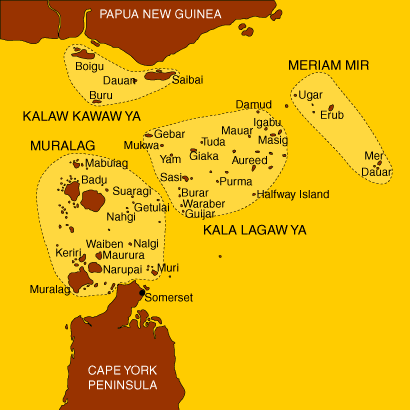The Aboriginal Flag
   
Link to the Dreamtime Task
The Aboriginal Flag is divided horizontally into equal halves of black (top) and red (bottom), with a yellow circle in the centre.
The black symbolises Aboriginal people and the yellow represents the sun, the constant re-newer of life. Red depicts the earth and peoples' relationship to the land. It also represents ochre, which is used by Aboriginal people in ceremonies.
The flag - designed by Harold Joseph Thomas, a Luritja man from Central Australia - was first flown at Victoria Square, Adelaide on National Aborigines' Day on 12 July 1971. It was used later at the Tent Embassy in Canberra in 1972.
Today the flag has been adopted by all Aboriginal groups and is flown or displayed permanently at Aboriginal centres throughout Australia.

The Torres Strait Islander Flag
 The Torres Strait Islander Flag - designed by the late Bernard Namok from Thursday Island - stands for the unity and identity of all Torres Strait Islanders. The Torres Strait Islander Flag - designed by the late Bernard Namok from Thursday Island - stands for the unity and identity of all Torres Strait Islanders.
It features three horizontal coloured stripes, with green at the top and bottom and blue in between - divided by thin black lines.
A white dharri or deri (a type of headdress) sits in the centre, with a five-pointed white star underneath it.
The colour green is for the land. The dharri or deri is a symbol for all Torres Strait Islanders. The black represents the people. The blue is for the sea.
The five-pointed star represents the island groups. Used in navigation, the star is also an important symbol for the sea-faring Torres Strait Islander people. The colour white of the star represents peace.

|
To-day (1923), the living descendants of the Aboriginals are the tribes of who roam across the northern and central portions of Australia. They live in the same state as their forefathers did many centuries before the boom of the white man's gun broke the stillness of their hunting grounds.
The Aboriginals have a remarkable knowledge of Nature, a complex social system, and, where unpolluted by contact with degraded white men, a high moral sense.The Aboriginal, wandering through the dark virgin forest and over the wooded hills, wondered at the mysteries of nature which surrounded him. He saw the warm sun rise from behind the mountains in the east, travel across the blue vault of the sky, and again sink beneath the earth far to the west. When the shadow of night was across the land, he slept beneath a canopy of clouds whose dimness was lit by the light of the moon and studded with golden stars.
In fern-grown gullies, he heard the music of running water as the tiny creek rippled over its stony bed. From the hills, he saw the silver river winding its way through rocky mountain gorges to the distant sea. The flood waters, sweeping down from the snow-capped mountains, were a living thing of terror. With a deep, sullen roar, they carried all before them, and Death followed swiftly on their turbulent tides. Far in the distance the sea glinted like fire in the noon-day sun. Men told strange tales of the sea and the dark, frowning cliffs that guarded the land, while the green surf, carrying with it strange treasures of the deep, thundered on the golden beaches.
The sky was the dwelling place of spirit men who caused the face of the sun to grow dark, the purple shadows to creep across the hills, and the rain to patter softly through the trees. When the white clouds gathered, the wind sang softly through the reeds, like a voice mourning the dead, or howled eerily through the trees in the forest. The voice of the thunder, echoing through the mountain hollows, and the lightning, flashing its golden fire across the sky, caused him to crouch in terror lest the wrath of the storm-god should fall heavily upon him. The unfathomable secret of life and death was ever before him. To the silent wonder of death was added the beautiful gift of dreams-that magic mirror of sleep wherein he saw men long since dead, and lived again in the dim remembered land of the past.
He heard the song of the bush, the laugh of the kookaburra greeting the dawn of a new day, and the mournful notes of the night birds betokening its close. When the warm breath of spring woke the sleeping spirit of the bush, she covered the land with a flower-woven covering of scarlet and gold, soft green and purple, like a silken tapestry fallen from the loom of the sun. The wild bees droned drowsily in the noon day, and carried their honey to a nest in some tall gum tree. All the bush echoed with the song of life.
Adapted from W.E.Thomas (Whitcombe & Tombs Ltd 1923).
Top
|